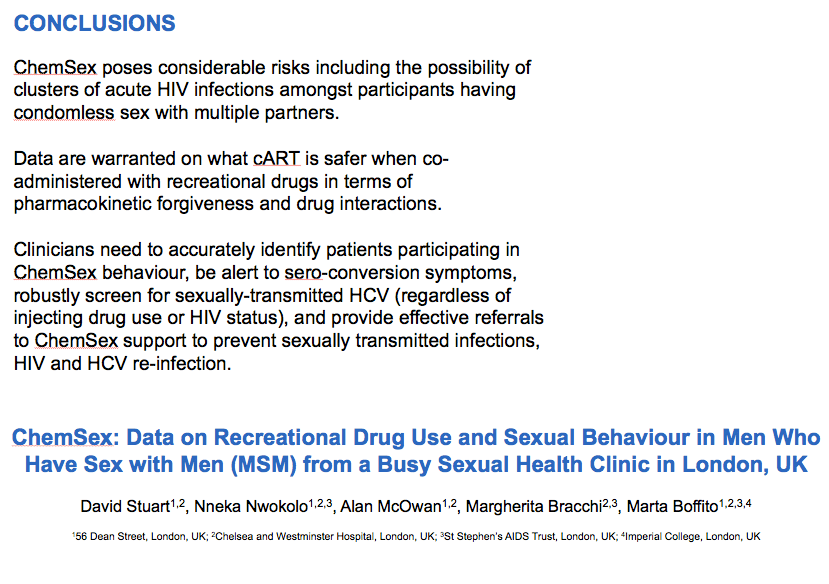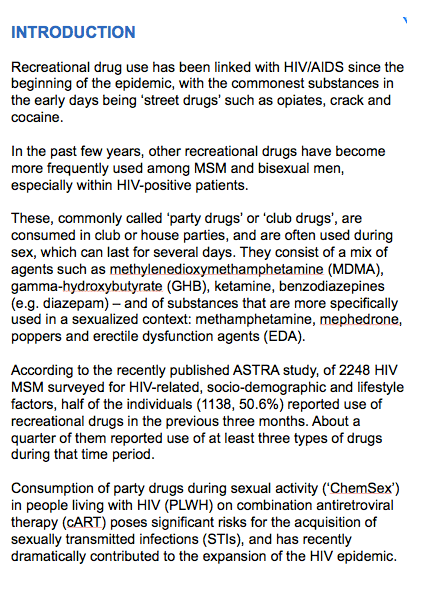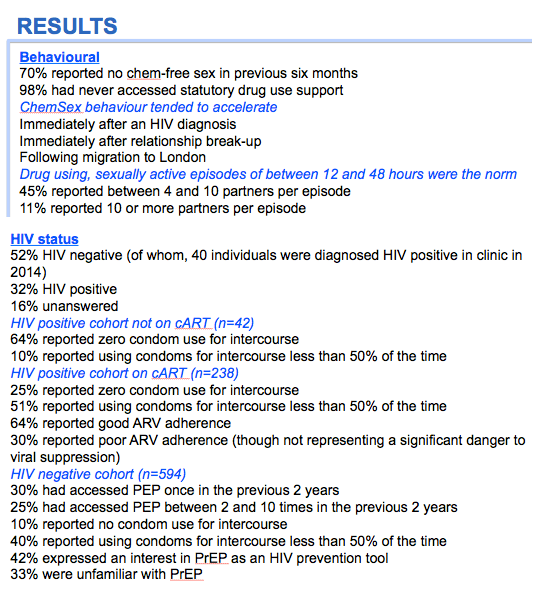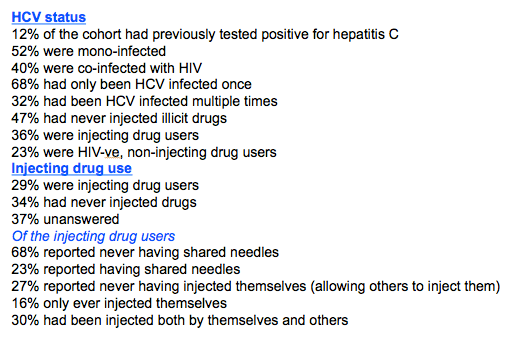 |
 |
 |
| |
ChemSex: Data on Recreational Drug Use and Sexual Behaviour in
Men Who Have Sex with Men (MSM) from a Busy Sexual Health Clinic in London, UK
|
| |
| |
Reported by Jules Levin
EACS 2015 Oct 21-24 Barcelona, Spain
David Stuart1,2, Nneka Nwokolo1,2,3, Alan McOwan1,2, Margherita Bracchi2,3, Marta Boffito1,2,3,4
156 Dean Street, London, UK; 2Chelsea and Westminster Hospital, London, UK; 3St Stephen's AIDS Trust, London, UK; 4Imperial College, London, UK
"we collected data on 874 individuals attending a ChemSex support service in a London sexual health clinic over the course of one year......64% HIV+ not-on-ART reported no condom use and 51% HIV+ on-ART (n=238) reported less than 50% of condom use; 30% poor ART adherence......29% were injecting drug users.....23% reported having shared needles"
HCV Status:
- 12% of the cohort had previously tested positive for hepatitis C
- 52% were mono-infected
- 40% were co-infected with HIV
- 68% had only been HCV infected once
- 32% had been HCV infected multiple times
- 47% had never injected illicit drugs
- 36% were injecting drug users
- 23% were HIV-ve, non-injecting drug users

Program abstract
ChemSex: Data on Recreational Drug Use and Sexual Behavior in Men Who Have Sex with Men (MSM) from a Busy Sexual Health Clinic in London, UK
D. Stuart1,2, N. Nwokolo1,2,3, A. McOwan1,2, M. Bracchi2,3, M. Boffito1,2,4
156 Dean Street, London, United Kingdom, 2Chelsea & Westminster Hospital, London, United Kingdom, 3St Stephens Center, London, United Kingdom, 4Imperial College, London, United Kingdom
Objectives: ChemSex (the use of certain recreational drugs [chems], e.g. crystal methamphetamine, gamma-hydroxy butyric acid [GHB] and mephedrone, to facilitate sex by MSM) is of increasing concern in cities that host larger MSM communities around the globe. One London-based sexual health clinic studied 874 individuals presenting to a ChemSex support clinic over the course of one year, to identify trends and determine risks, motivations and consequences of ChemSex behaviour.
Methods: Individuals were asked by substance use support workers to disclose details of their behaviour and risk, including condom use, frequency of drug-using episodes, ART adherence, partners' number, HIV/HCV, injecting drugs, numbers of post-exposure prophylaxis (PEP) courses and experience of chem-free sex.
Results: 70% individuals reported no chem-free-sex in the previous 6 months, 98% had not received drug use support. ChemSex accelerated after HIV diagnosis. 52% were HIV-ve and 32% HIV+ve. 64% HIV+ve-not-on-ART reported no condom use and 51% HIV+ve-on-ART (n=238) reported less than 50% of condom use; 30% poor ART adherence. 25% HIV-ve (n=594) reported PEP 2-10 times over past 2 years, 10% no condom use, 40% condom use 50% of times. 29% injected drugs. 52% were mono-infected with HCV, 40% co-infected HIV/HCV.
Conclusion: ChemSex poses considerable risks including the possibility of clusters of acute HIV infections amongst participants having condomless sex with multiple partners. Data are warranted on what ART is safer when co-administered with recreational drugs in terms of pharmacokinetic forgiveness and drug interactions. Clinicians need to accurately identify patients participating in ChemSex behaviour, be alert to sero-conversion symptoms, robustly screen for sexually-transmitted HCV (regardless of injecting drug use or HIV status), and provide effective referrals to ChemSex support to prevent sexually transmitted infections, HIV and HCV re-infection.





|
| |
|
 |
 |
|
|